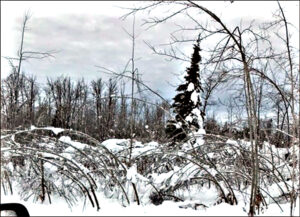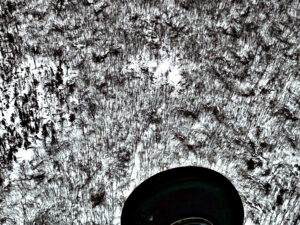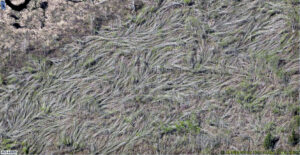
Aspen saplings in Douglas County were left permanently bent over after sustaining the burden of the immense weight of ice and cemented snow loads on stems and branches. / Photo Credit: Paul Cigan, Wisconsin DNR
By Paul Cigan, DNR Forest Health Specialist, Hayward;
Paul.Cigan@wisconsin.gov or 715-416-4920
Wisconsin weather is often dealt out in extremes and excess.
This year, winter has gotten off to a mild start, but in mid-December 2022, tens of thousands of acres of forest land in Douglas, Sawyer and Washburn counties was permanently changed by a generational winter storm that became famously known as the “Blue Blizzard of 2022.”

Exceptionally high-water-content snow from the December 2022 blizzard displayed a spectacular glacial blue color, lending to the name of the storm that delivered it: “The Blue Blizzard of 2022.” / Photo Credit: National Weather Service
The powerful, long-in-duration winter storm, which ran from Dec. 13-16, 2022, brought freezing rain, sleet and exceptionally wet snow. It caused severe storm damage over tens of thousands of acres of forests in those Wisconsin counties and large swaths of northern Minnesota.
Freezing rain kicked off the storm and quickly morphed into a mix of sleet and exceptionally wet and heavy snow, with snowfall totals reaching up to 30 inches near Lake Superior. Water-laden snow built up and froze like cement on tree stems and branches, leaving trees bent over in half-circles or completely snapped off under the immense weight of layers of snow and ice.
Downed trees and power lines created widespread power outages – lasting nearly a week in some rural areas – and the closure of recreational trails that took months to clear of fallen debris.
The snow’s abnormally wet and dense properties in the region absorbed a higher degree of light in the red portion of the spectrum and emphasized reflectance from the blue part. This imparted a spectacular glacier-blue color in cracks and holes in snow surfaces. The National Weather Service Office in Duluth named the storm.
A rare Wisconsin Department of Natural Resources winter aerial survey mission recorded more than 75,000 acres with moderate to heavy storm damage. The most dramatic damage occurred in southwestern Douglas County in the town of Dairyland, with a slightly lighter band of damage seen east into the town of Solon Springs and north extending to the town of Superior.
While damage broadly affected trees 7 to 30 years old, the most heavily impacted species and age class was pole-sized aspen ranging from 10-20 years old (i.e., 1-3 inches diameter at breast height). These trees were completely bent over and frozen to the ground for the duration of the winter, with a complete lack of straightening observed since that time. However, bent-over trees have not died or displayed symptoms of insect or disease activity. Birch and jack pine also sustained damage but to a lesser extent.

A rare winter aerial survey mission recorded more than 76,000 acres with moderate to heavy storm damage in the western half of Douglas County. / Map Credit: Wisconsin DNR
The Douglas County Forestry Department, the most heavily impacted forest ownership in the storm’s footprint within the state, responded to the storm by pairing traditional and technologically driven methods to evaluate, monitor and manage their extensive storm damage. The county contracted with an aerial imagery vendor to acquire and analyze true-color aerial imagery to perform fine-scale salvage reconnaissance over tens of thousands of forested acres within their ownership.
Following the snowmelt in 2023, initial ground surveys focused on economically high-value forests – primarily red pine plantations – to determine if salvage harvests were needed to prevent pest breakouts and capture the economic value of damaged trees. This initial effort also included the evaluation of jack pine stands in which supplemental treatments could help maintain jack pine on the landscape. However, when it came to evaluating aspen stands, the county forest’s largest and most severely storm-damaged cover type, field checks were not practical.
High-resolution (i.e., one-sixth of an inch) aerial imagery overlaid with vegetative indexing (to detect changes in forest canopy health) was used to gauge tree damage severity across the county. Aspen stands were given a rating of low, moderate or severe to determine operational feasibility to salvage and monitor targets.
With a baseline assessment complete, various stand treatment methods were tested (e.g., straight blading and mulching) to determine production rates and potential costs. Evaluation, treatments and monitoring are still ongoing, but it’s clear the county’s “boots on the ground and eyes in the sky” approach will provide a helpful framework for future response to large-scale storms.
While this long storm recovery process continues, evidence of the Blue Blizzard of 2022 will remain another scar from Mother Nature’s unpredictable character.

An aerial view of an aspen forest with severe winter storm damage in Douglas County. / Photo Credit: Paul Cigan, Wisconsin DNR

A mid-May aerial view of an aspen forest with trees showing no straightening after a winter of being bent over due to heavy snowpack in Douglas County. / Photo Credit: Douglas County Forestry Department and All EagleView Technology Corporation.
